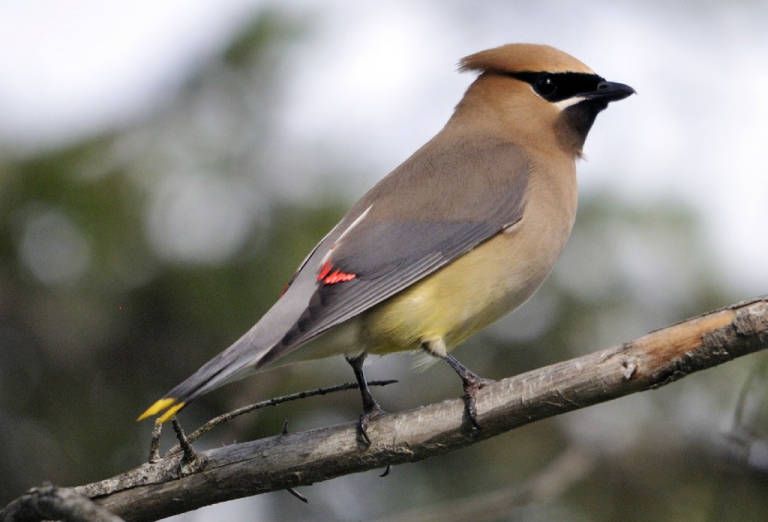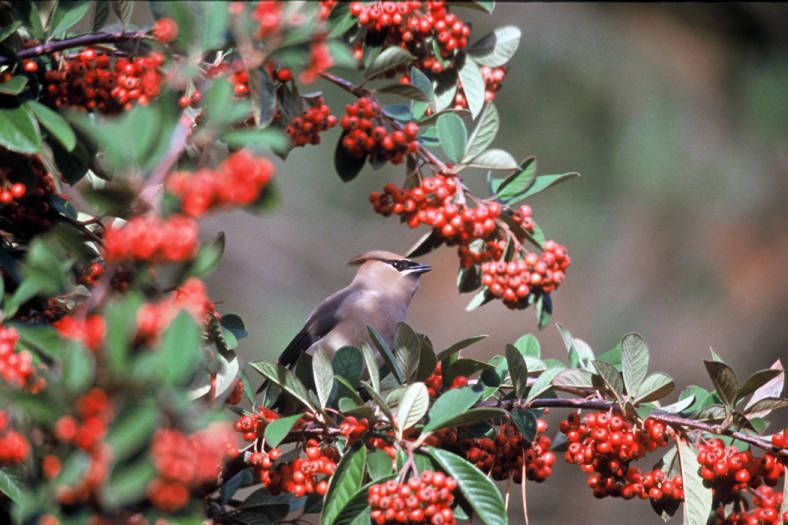Identification
This fact sheet describes a common wintering bird in Florida called the cedar waxwing (Bombycilla cedrorum). Information in this fact sheet is relevant to homeowners, backyard bird enthusiasts, and the general public. The cedar waxwing is an enchanting bird known for its graceful appearance. Its plumage boasts a luxurious blend of browns, grays, and lemon-yellow hues, adorned with a modest crest (Figure 1). It has a distinctive ebony mask, and striking red wax-like accents on its wing. In Florida, cedar waxwings begin to arrive in October and stay until May.
These birds assemble in sizable flocks, indulging in a banquet of fruits from loquats (Eriobotrya japonica), cedar berries (Juniperus virginiana), holly berries (Ilex aquifolium), and sabal palmetto (Brassica oleracea). They often travel in large flocks, and people can hear their melodious and high-pitched whistles as the birds fly from tree to tree.

Credit: Bill Thompson, USFWS National Digital Library
Habitat
Cedar waxwings live in a wide range of urban to rural habitats throughout Florida. They are often found in deciduous, coniferous, and mixed forests, particularly those that contain fruiting trees. Notably, cedar waxwings are frequently found in urban and suburban landscapes, thanks to the growing prevalence of ornamental fruit trees in cities. Observers can commonly spot them in open woodlands, parks, gardens, forest edges, and second-growth forests. They are found in Florida during the winter only.
Movement and Migration
Cedar waxwings are migratory birds, traveling from the north to the south in the fall and from the south to the north in the spring. Although many eastern cedar waxwings choose to spend their winters in the southeastern United States, some venture as far south as Costa Rica and Panama. In northern Ohio, cedar waxwings appear irregularly as winter residents, forming occasional flocks in lake areas. They are also known to make winter visits to the larger Lake Erie Islands in the northern parts of the U.S.
Behavior
Social by nature, cedar waxwings often gather in substantial flocks and establish loosely organized nesting colonies, each encompassing a dozen or more nests. They also form large flocks when they are foraging for fruit in the winter. When feasting on fruit, they exhibit a unique behavior of meticulously selecting and consuming one fruit at a time. Their proficiency in feeding allows them to adeptly perch on branches and even pluck berries while briefly hovering just below clusters. During the courtship phase, males and females engage in playful interactions characterized by back-and-forth movements and the occasional exchange of small tokens, such as berries, insects, or flower petals.
Diet
Cedar waxwings are predominantly frugivorous, with a year-round focus on fruit. In Florida, their diverse fruit diet encompasses a variety of species during winter, including cabbage palm (Sabal palmetto), mulberries (Morus alba), dogwood (Cornus florida), and raspberries (Rubus idaeus). Additionally, they relish mistletoe (Phoradendron serotinum), red cedar (Juniperus virginiana), honeysuckle (Lonicera periclymenum), southern crabapple (Malus angustifolia), parsley hawthorn (Crataegus marshallii), and holly (Llex spp.) fruits (Figure 2). During the summer, cedar waxwings augment their diet with protein-rich insects, such as mayflies, dragonflies, and stoneflies, often captured mid-flight. Cedar waxwings are also known to pluck scale insects, spruce budworms, and leaf beetles directly from vegetation.

Credit: Karney, Lee, USFWS National Digital Library
Nesting and Reproduction
Although they do not breed in Florida, cedar waxwing pairs collaboratively search for nesting sites, with the final choice resting with the female. Their preferred nesting locations typically involve the fork of a horizontal branch, ranging from 3 to 50 feet above the ground. Various tree species serve as nesting sites, including maples, pines, red cedar, white cedar, apple, pear, hawthorn, and bur oak. On occasion, cedar waxwings opt for vertical forks, vine tangles, or even single horizontal branches.
Female cedar waxwings lay clutches of 2–6 eggs and diligently incubate them for 11–13 days. Typically, 1–2 broods emerge from the eggs, remaining in the nest for around 14–18 days. Newly hatched nestlings are notably vulnerable, appearing weak, featherless, and blind, and remaining remarkably quiet.
Conservation Status
In North America, cedar waxwing populations have remained stable and have slightly increased during the period of 1966 to 2019 (Cornell University n.d.; USGS n.d.). Across North America, this avian species has a low conservation concern, rated at 6 out of 20 on the Continental Concern Score by Partners in Flight (Partners in Flight Databases 2024). An estimated global breeding population of 64 million cedar waxwings underlines their healthy status (Cornell University n.d.). Since the 1970s, the upswings in population are attributed in part to the conversion of fields into shrublands and forests, alongside the increased utilization of fruit-bearing trees in cities. Nevertheless, cedar waxwings face certain risks, most prominent of which are window collisions and occasional vehicle accidents due to their feeding on fruiting trees along roadsides.
Throughout Florida, cedar waxwings are known to fly into windows. Like many other bird species, they mistake windows for safe passageways if they can see through the windows to the other side. Additionally, they may see a reflection of trees or sky and think they can fly through the window. They tend to collide with windows more frequently during the winter months. The question arises: Why is this the case? The answer lies in their dietary preferences. Cedar waxwings have a distinct fondness for cabbage palm berries, loquats, and holly berries. What makes these berries particularly appealing to these birds is that they persist on the trees even as the days grow colder. However, these berries are often fermenting and cause the birds to get “drunk.” The birds fly erratically and are prone to hitting windows after eating fermented berries.
As the winter season sets in, the supply of other food sources dwindles, and the reliable presence of these berries becomes crucial for the waxwings. This seasonal scarcity compels them to seek out the remaining available berries so they can sustain themselves during the colder months. This intensified search for food often leads them to urban and suburban areas where ornamental berry trees are planted, including those near buildings and windows.
A solution to mitigate bird collisions with windows is to reduce the reflective quality of the glass. This can be accomplished through a few simple methods (American Bird Conservancy n.d.):
- Curtains and blinds: Partially closing curtains and blinds can sometimes help to break up the reflection and make the window more visible to birds. However, if the reflection is strong, inside curtains or blinds have little effect.
- Tape strips and window decals: Using tape strips or window decals in strategic patterns on the glass can make it more apparent to birds that there is an obstacle.
- Tempera paint: Applying tempera paint to the windows with a sponge or brush can effectively reduce transparency. This method can also allow for creative and artistic designs to be added to your windows.
- Parachute cord: A popular “do-it-yourself” method is to hang parachute cord every four inches to break up the reflection. Four inches is a narrow enough interval to make most birds think they cannot fly through the window (Acopian BirdSavers n.d.).
References
Acopian BirdSavers. n.d. https://www.birdsavers.com/
Alberta Institute for Wildlife Conservation. 2022. “Winter, Waxwings, and Window Strikes.” Accessed October 24, 2023. https://www.aiwc.ca/blog/winter-waxwings-and-window-strikes/
American Bird Conservancy. n.d. “Glass Collisions: Preventing Bird Window Strikes.” https://abcbirds.org/glass-collisions/
Brugger, K. E., L. N. Arkin, J. M. Gramlich, S. Journal, and N. Summer. 1994. “Migration Patterns of Cedar Waxwings in the Eastern United States (Patrones de Migración en Bombycilla cedrorum en el este de los Estados Unidos de América).” J. Field Ornithol. 65 (3): 381–387.
Cornell University. n.d. “Cedar Waxwing Life History.” All About Birds. Accessed October 12, 2023. https://www.allaboutbirds.org/guide/Cedar_Waxwing/lifehistory
National Audubon Society. n.d. “Cedar Waxwing.” Bird Guide. Accessed October 24, 2023. https://www.audubon.org/field-guide/bird/cedar-waxwing
Partners in Flight Databases. 2024. “Avian Conservation Assessment Database Scores.” https://pif.birdconservancy.org/ACAD/Database.aspx
Putnam, L. S. 1949. “The Life History of the Cedar Waxwing.” The Wilson Bulletin 61 (3): 141–182. http://www.jstor.com/stable/4157788
Sheppard, C. n.d. “You can save birds from flying into windows.” American Bird Conservancy.
USGS. n.d. “Eastern Ecological Science Center – Bird Population Studies.” https://www.mbr-pwrc.usgs.gov/